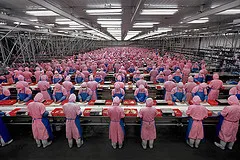
China’s flash manufacturing PMI dips to 49.4 in September
HSBC says the country won’t suffer a hard landing yet as exports growth has expanded over 20% despite the weaker external demand.
Domestic demand is still resilient, and is sufficient to support around 8.5-9% growth in the coming quarters.
Here’s more from HSBC:
| Flash PMI reading dipped marginally to 49.4 in September from 49.9 in August. This is a similar picture of moderating growth as for the previous two months. Fears of a hard landing are unwarranted. External demand has weakened yes, but exports growth has not collapsed. Even as exports growth softens further in coming months, China is less dependent on the net exports, whose contribution to GDP growth was almost zero in 1H. Still resilient domestic demand is sufficient to support around 8.5-9% growth in the coming quarters. Facts At 49.4, the flash reading of HSBC China manufacturing PMI came in lower than August's final PMI of 49.9 and a touch higher than 49.3 in July. This was mainly driven by 1pt fall of output (49.2 vs 50.2 in August) taking output back to below-50 territory, as new business flows remained weak: new orders flat at 49.2 for two months and new export orders edging down to 49.5 (vs. 49.6 in August). Employment showed fell into contraction territory again (49.5 vs. 50.3 in August), but only marginal. Judging by the difference between new orders and finished goods inventories (2.7 flash reading vs. 2 in August), growth momentum was slightly better than the headline reading. Prices rebounded again, close to levels seen in 2Q. Input prices rose to a four month high of 58.8 in September (vs. 55.9 in August). Output prices surged to a five month high of 54.5 in September (vs.52.3 in August). Implications: The third month of below 50 reading implies that China's manufacturing sector will see weakening sequential growth in the coming months. This is a similar picture of moderating growth as in the previous two months: the impact of tightening continues to filter through as the external outlook starts to weaken. That said, we still think fears of a hard landing are unwarranted. On external front: - External demand just weakened a little but didn't take the toll on exports growth as official exports growth still expanding at over 20% y-o-y. - We do expect exports growth to moderate in the coming months, but unlikely to fall into a total collapse seen in 2008/09 assuming global economy will experience a depression not a recession. - Even if exports growth fell, the impact should be much smaller than in previous crisis because China is less dependent on the net exports in the post crisis era with net exports representing 2-3% of GDP (vs. 7-8% in 2007/08) and contributing marginally to GDP growth in 1H. On domestic front: - Still resilient domestic demand is sufficient to support around 8.5-9% growth in the coming quarters. - Investment growth has been stronger than expected so far and will continue to find support from over 100,000 ongoing investment projects, public housing construction and resilient consumer spending. - Consumer spending will hold up well thanks to two-year strong wage growth and still tight labour market. Although we believe headline inflation peaked in July, the rebound of prices indices highlights the still high inflationary pressures. China's inflation slowdown will likely to be very gradual in coming months. Bottom line: Growth continues to moderate but the economy is still cooling at a controlled pace. With less dependence on net exports, China's resilient domestic demand should support around 8.5-9% growth in coming quarters. CPI has peaked but its subsequent slowdown is likely to be very gradual. We expect the PBoC to maintain a stable monetary policy for the rest of this year. |
Photo from caffeineguy



![SBR 5 Lorem Ipsum News 2 [8 May]](https://cmg-qa.s3.ap-southeast-1.amazonaws.com/s3fs-public/styles/exclusive_featured_article/public/2025-05/a_hand_pointing_to_a_futuristic_technology_5b87c9d0e3_3.png.webp?itok=M3Hf-9XR)
![SBR 4 Lorem Ipsum [8 May Top Stories]](https://cmg-qa.s3.ap-southeast-1.amazonaws.com/s3fs-public/styles/exclusive_featured_article/public/2025-05/a_hand_pointing_to_a_futuristic_technology_5b87c9d0e3_2.png.webp?itok=2m5Wl0MX)


![Exclusive three SBR 12 Lorem Ipsum [8 May]](https://cmg-qa.s3.ap-southeast-1.amazonaws.com/s3fs-public/styles/exclusive_featured_article/public/2025-05/a_hand_pointing_to_a_futuristic_technology_5b87c9d0e3_11.png.webp?itok=8kn_UIfA)
![SBR 3 Lorem Ipsum [ Exclusive 2]](https://cmg-qa.s3.ap-southeast-1.amazonaws.com/s3fs-public/styles/exclusive_featured_article/public/2025-05/a_hand_pointing_to_a_futuristic_technology_5b87c9d0e3_1.png.webp?itok=YCyjLegJ)
![SBR 2 Lorem Ipsum [8 May]](https://cmg-qa.s3.ap-southeast-1.amazonaws.com/s3fs-public/styles/exclusive_featured_article/public/2025-05/a_hand_pointing_to_a_futuristic_technology_5b87c9d0e3_0.png.webp?itok=_cKD-29o)

![Video [Event News]](https://cmg-qa.s3.ap-southeast-1.amazonaws.com/s3fs-public/styles/event_news_featured_article/public/2025-05/screenshot-2025-05-08-at-4.58.53-pm_0.png.webp?itok=Kud35sMs)
![Event News SBR 9 Lorem Ipsum [8 may]](https://cmg-qa.s3.ap-southeast-1.amazonaws.com/s3fs-public/styles/event_news_thumbnail/public/2025-05/a_hand_pointing_to_a_futuristic_technology_5b87c9d0e3_8.png.webp?itok=DTh_dbYp)
![Event News SBR 9 Lorem Ipsum [8 May]](https://cmg-qa.s3.ap-southeast-1.amazonaws.com/s3fs-public/styles/event_news_thumbnail/public/2025-05/a_hand_pointing_to_a_futuristic_technology_5b87c9d0e3_7.png.webp?itok=vzDAzb6V)
![Event News SBR 8 Lorem Ipsum [8 May]](https://cmg-qa.s3.ap-southeast-1.amazonaws.com/s3fs-public/styles/event_news_thumbnail/public/2025-05/a_hand_pointing_to_a_futuristic_technology_5b87c9d0e3_6.png.webp?itok=jvHFc4P6)
![Video [Event News]](https://cmg-qa.s3.ap-southeast-1.amazonaws.com/s3fs-public/styles/video_thumbnail/public/2025-05/screenshot-2025-05-08-at-4.58.53-pm_0.png.webp?itok=yZnI0YBb)
![Video 1 SBR [8 May]](https://cmg-qa.s3.ap-southeast-1.amazonaws.com/s3fs-public/styles/video_thumbnail/public/2025-05/screenshot-2025-05-08-at-4.58.53-pm.png.webp?itok=9AAeRz_k)

 Advertise
Advertise

